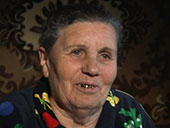
Raisa Teplitskaia was born in 1931 in Ternivke. She grew up with two sisters and one brother. Her father was a blacksmith and her mother was a homemaker and raised pigs. She went to a Ukrainian school. She survived the war in hiding in a village. After the war, she returned to Ternivke, before settling in Uman in 1952. She has three sons, one of whom lives in Germany, and a daughter.
Matzo Baking with Neighbors
Uman, Ukraine
Raisa Teplitskaia remembers her mother's tireless efforts to get everything ready for her family's Passover celebration. In particular, she recalls her parents' and neighbors' combined efforts to bake matzos in their home.
Whereas today matzo is distributed by the Federation of Jewish Communities and is readily available for pickup in Jewish community centers and synagogues throughout the region, acquiring matzo—or more commonly, the flour used to bake it—in prewar Soviet Union was difficult.
Preparations for the Passover holiday often began months before the beginning of the festival, thereby lengthening the sacred time associated with it. Passover was transformed from an eight-day festival into a full season of preparation, culminating in the celebration of the holiday itself. Most people baked matzo themselves at home from flour obtained either in the marketplace, when flour was still available for purchase in the 1920s and early 1930s, or from state stores.
Often foreign currency sent to them by relatives abroad helped smooth the purchase of flour. Others obtained it in November, when it was distributed in commemoration of the October Revolution, and stored it until needed for Passover four or five months later.
Source: Jeffrey Veidlinger, In the Shadow of the Shtetl: Small-Town Jewish Life in Soviet Ukraine (Indiana University Press, 2013)
